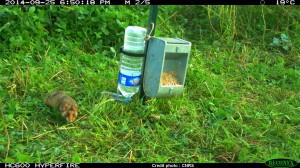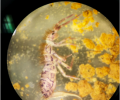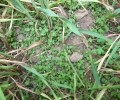26 September 2014: CNRS lets 14 farmed hamsters loose in a large paddock
23 décembre 2014CNRS recently released a number of hamsters into a large 3,000-m2 paddock, as part of Action D2. The paddock enjoys a dense layer of coverage, rich with different grass species, purple clover and alfalfa, guaranteeing a high concentration of those insects and invertebrates so well-liked by hamsters. Their diets are supplemented with wheat germ, sunflower seeds, cabbage and potatoes.
 The 14 hamsters (10 female and 4 male) released were equipped with transponders* so as to be identifiable using the antenna erected in the middle of the paddock, itself linked up to three photo traps set up at strategic points across the paddock (food and water dispenser points).
The 14 hamsters (10 female and 4 male) released were equipped with transponders* so as to be identifiable using the antenna erected in the middle of the paddock, itself linked up to three photo traps set up at strategic points across the paddock (food and water dispenser points).
The facility, based near a circulation path, was intended for a two-fold purpose: first of all, to establish the degree of ease with which the animals are able to find their way to the fauna passageways, aka “ecoducts” set up underneath the roads; and, secondly, to test the anti-predation systems developed by CNRS, as the fauna passageways do not, for the time being, protect small mammals from their natural predators.
Next Spring, once the animals have become acclimated to their new environment and hibernated, the anti-predation systems will be tested in real-life conditions, inside the paddock.
*The transponder is a device used to electronically identify animals. They are small electro-magnetic systems a few millimetres in size, placed under the animals’ skin and containing a unique identification number.



